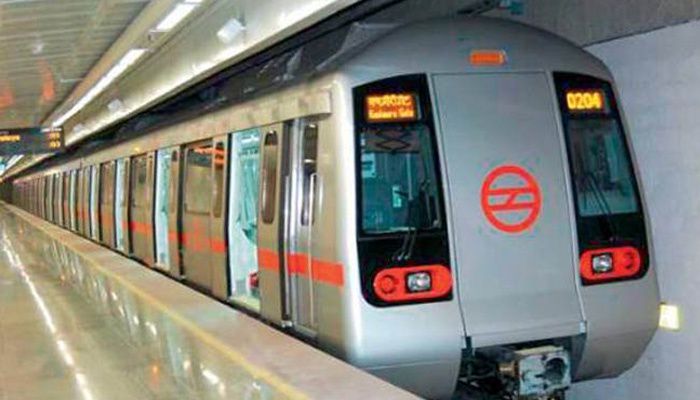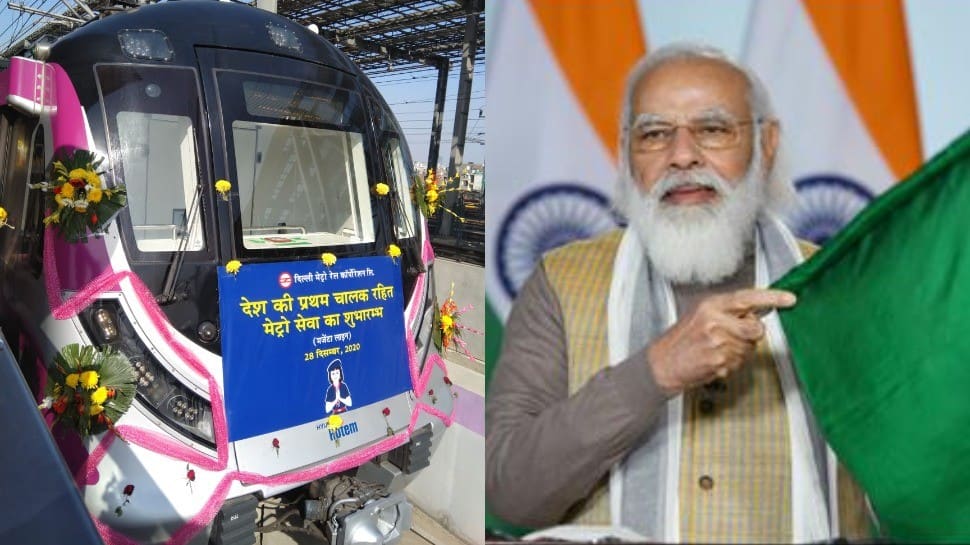
India Gets Its 1st Dazzling Driver-Less Metro Train As Prime Minister Narendra Modi Inaugurates The Event Virtually
India is a developing country with rich resources and labor in hand.
Step by step, India is moving to a more technology fueled country. And to add to one of its technology milestones, India is adding its name to a list of countries with driverless trains. Yes, prime minister Narendra Modi has inaugurated India’s first driverless metro train through a virtual event in Delhi.
The train lies on Delhi Metro’s magenta line. This line connects Janakpuri west in west Delhi to Noida’s botanical garden. Officials say that these driver-less trains will eliminate the possibility of a human-made error made as it is going to be fully automated. There are also plans that by mid-2021, this line might be extended to Delhi Metro’s Pink Line.
Prime minister Narendra Modi also launched the National Common Mobility Card. This card operates as an inter-operable transport facility. All transactions and payments for retail shopping, money withdrawals, travel expense, till duties, could be done with the National Common Mobility Card.
As per the official report, Today, with this inauguration, Delhi metro rail corporation join the prestigious league of 7% of the world driver-less operating metro network. This news is such an encouraging one and it shows how India is moving swiftly to a better tomorrow with technology. Prime minister Narendra Modi reminisced how the efforts of Bihari Vajpayee Ji was got Delhi its first Metro train.

He also added that when he sat on the PM seat in 2014, metro services were only available in 5 cities and now, in 2020, India has metro services in 18 cities. Also adding that we can expect more than 25 cities to join the metro network by 2025. While inaugurating this ground-breaking event, prime minister Narendra Modi puffed with pride that this day, this event marks how swiftly India is moving to a smart system.
This driver-less train, that has started its journey will speak history for India. Prime minister Narendra Modi always loves talking with facts. We don’t need statistics, every time Prime Minister comes to the stage, he gives it out immensely.
PM states that there were only 248 kilometers of the operational metro line in India during the period of 2014, but right now, in 2020, that it’s three times that calculation, and by 2025, the government seems to be aiming to expand it to 1700 kilometers.
Prime minister Narendra Modi takes immense pride in promoting Atmanirbhar Bharat. The Prime minister said that this “Make in India” scheme alluded to the increase in the Indian economy. He adds, how important make in India scheme is, and to mark his words, this metro service seems to be an example of it.
It has reduced costs, and have saved foreign currency while also increasing employment for Indian people. With the flagship, make in India flying high, prime minister Narendra Modi referred to this occasion of today’s launch as ‘the next generation infrastructure’ for the nation’s capital. Beginning his speech, the prime minister addressed the issue of how before the ruling, the Indian government wasn’t thinking ahead of time for the future and how half-hearted their work was being done confusing around.

The Prime minister now, asks us to see, how futuristic he is in his thinking and inaction. He stated that modern thinking calls to look at urbanization as an opportunity and not as a challenge. By using this opportunity, India should invest in building infrastructure that needs necessary attention and use it to ease the continuous marathon of living.
Narendra Modi said that this difference in thinking is what taking India in the right direction and this growth in urbanization is very much necessary. As for the National Common Mobility Card, it could be enabled for anyone who carries a Ru-pay debit card issued from any part of the country to travel on the route. This will be fully operationalized on Delhi Metro’s airport express line, say officials.
The PMO has said, by 2023, this facility will be made available for the entire metro network. Since 2002, the Delhi metro has been undergoing much technological development with its trains and stations. This new driver-less train will be the latest and most developed one to add to the list of accomplishments over the past 18 years.
The station has also seen to have made changes in its railway general rules to allow the transmission of driverless trains. Trains will be remotely controlled from common rooms also known as the operations control center. Teams of engineering will be tracking its movement and monitoring its controls. The drivers cannot drive above the constant limit set by the automatic train protection (ATP) system.

The commanding, instructions, and precautions are all taken through the communication-based train control (CBTC) signally technology. If we are to look closer at this aspect, this event is a proud moment for India, and it is something that provides us with a glimpse of what the future waits for us. In India, there is no shortage of resources or labor, if the government keeps their intentions pure and invest in such infrastructural development that one is going to make our daily lives easy then it is something we should welcome with an open heart.
India is a developing country with rich resources and labor in hand. Step by step, India is moving to a more technology fueled country. And to add to one of its technology milestones, India is adding its name to a list of countries with driverless trains. Yes, prime minister Narendra Modi has inaugurated India’s first driverless metro train through a virtual event in Delhi.
The train lies on Delhi Metro’s magenta line. This line connects Janakpuri west in west Delhi to Noida’s botanical garden. Officials say that these driver-less trains will eliminate the possibility of a human-made error made as it is going to be fully automated. There are also plans that by mid-2021, this line might be extended to Delhi Metro’s Pink Line.
Prime minister Narendra Modi also launched the National Common Mobility Card. This card operates as an inter-operable transport facility. All transactions and payments for retail shopping, money withdrawals, travel expense, till duties, could be done with the National Common Mobility Card.
As per the official report, Today, with this inauguration, Delhi metro rail corporation join the prestigious league of 7% of the world driver-less operating metro network. This news is such an encouraging one and it shows how India is moving swiftly to a better tomorrow with technology. Prime minister Narendra Modi reminisced how the efforts of Bihari Vajpayee Ji was got Delhi its first Metro train.
He also added that when he sat on the PM seat in 2014, metro services were only available in 5 cities and now, in 2020, India has metro services in 18 cities. Also adding that we can expect more than 25 cities to join the metro network by 2025. While inaugurating this ground-breaking event, prime minister Narendra Modi puffed with pride that this day, this event marks how swiftly India is moving to a smart system.
This driver-less train, that has started its journey will speak history for India. Prime minister Narendra Modi always loves talking with facts. We don’t need statistics, every time Prime Minister comes to the stage, he gives it out immensely.
 PM states that there were only 248 kilometers of the operational metro line in India during the period of 2014, but right now, in 2020, that it’s three times that calculation, and by 2025, the government seems to be aiming to expand it to 1700 kilometers. Prime minister Narendra Modi takes immense pride in promoting Atmanirbhar Bharat.
PM states that there were only 248 kilometers of the operational metro line in India during the period of 2014, but right now, in 2020, that it’s three times that calculation, and by 2025, the government seems to be aiming to expand it to 1700 kilometers. Prime minister Narendra Modi takes immense pride in promoting Atmanirbhar Bharat.
The Prime minister said that this “Make in India” scheme alluded to the increase in the Indian economy. He adds, how important make in India scheme is, and to mark his words, this metro service seems to be an example of it.
It has reduced costs, and have saved foreign currency while also increasing employment for Indian people. With the flagship, make in India flying high, prime minister Narendra Modi referred to this occasion of today’s launch as ‘the next generation infrastructure’ for the nation’s capital. Beginning his speech, the prime minister addressed the issue of how before the ruling, the Indian government wasn’t thinking ahead of time for the future and how half-hearted their work was being done confusing around.
The Prime minister now, asks us to see, how futuristic he is in his thinking and inaction. He stated that modern thinking calls to look at urbanization as an opportunity and not as a challenge. By using this opportunity, India should invest in building infrastructure that needs necessary attention and use it to ease the continuous marathon of living.
Narendra Modi said that this difference in thinking is what taking India in the right direction and this growth in urbanization is very much necessary. As for the National Common Mobility Card, it could be enabled for anyone who carries a Ru-pay debit card issued from any part of the country to travel on the route. This will be fully operationalized on Delhi Metro’s airport express line, say officials.
The PMO has said, by 2023, this facility will be made available for the entire metro network. Since 2002, the Delhi metro has been undergoing much technological development with its trains and stations. This new driver-less train will be the latest and most developed one to add to the list of accomplishments over the past 18 years.
The station has also seen to have made changes in its railway general rules to allow the transmission of driverless trains. Trains will be remotely controlled from common rooms also known as the operations control center. Teams of engineering will be tracking its movement and monitoring its controls. The drivers cannot drive above the constant limit set by the automatic train protection (ATP) system.
The commanding, instructions, and precautions are all taken through the communication-based train control (CBTC) signally technology. If we are to look closer at this aspect, this event is a proud moment for India, and it is something that provides us with a glimpse of what the future waits for us. In India, there is no shortage of resources or labor, if the government keeps their intentions pure and invest in such infrastructural development that one is going to make our daily lives easy then it is something we should welcome with an open heart.




